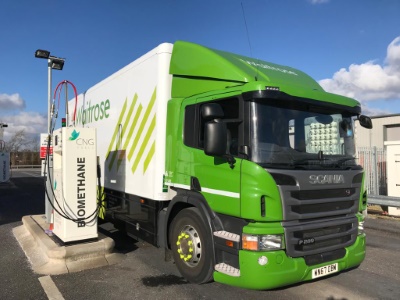Van and car deadline rowback sows doubt around wider EV shift

John Lewis Partnership, which incorporates Waitrose, is among the HGV operators adopting biomethane to help drive down greenhouse gas emissions. Image courtesy ReFuels
Confusion abounded last month over key government policy on the road transport decarbonisation agenda, after the deadline for ending the sale of new petrol and diesel-powered vans and cars was put back by five years to 2035 by the prime minister, Rishi Sunak.
Citing high upfront costs, practical concerns from small businesses, progress to be made on infrastructure and the need to strengthen the domestic automotive industry, Mr Sunak said he would “ease the transition to electric vehicles”, “to give us more time to prepare”. But there was no mention by the prime minister of any such concession for HGVs.
In late September, in a reiteration of existing policy, a spokesperson for the Department for Transport told us: “Government will phase out the sale of new, non-zero emission HGVs less than or equal to 26 tonnes from 2035. From 2040 all new HGVs sold in the UK must be zero emission.”
He added: “We will develop and consult on the appropriate regulatory framework to deliver the end of sales dates for new, non-zero emission HGVs, in due course.”
But it was unclear whether this policy had been reviewed in light of the diesel and petrol van/car phase-out postponement, or whether it might be in the future.
To compound the uncertainty, Labour has already pledged to reverse the government rowback on vans and cars should it win the next election. But industry insiders suggest that while the Conservatives’ U-turn was presented as being in the interests of consumers, the reality is that the government has realised that there is no way the generating and distribution system can support such a rapid transition to electricvehicles.
The news of the postponement threw a certain amount of shade onto a presentation on alternative fuels and power which Logistics UK’s deputy director, policy, Michelle Gardner, gave the same day to the first of this autumn’s Transport Manager conferences in Sparkford, Somerset, at which time there had been no clarity on whether the deadlines for non-zero- emission truck phase-out would be adjusted to suit.
But other legislative pressureto decarbonise remained unchanged, she said. Large firms were soon expected to face expansion of greenhouse gas emission reporting requirements, which would put pressure on transport contractors and third-party hauliers to measure, report and reduce emissions.
Deadline postponements aside, government remained focused on vehicle tailpipe emissions but there was little sign of decision-making, she said. Results from the government zero carbon road freight demonstrator programme had been due late last year and would have been used to inform decisions over infrastructure, but had still not been announced. The promised Low Carbon Fuel Strategy was still not published. She had been told the Government’s HGV infrastructure strategy might now be published next year!
In the absence of anything more substantial from government, the consensus from Logistics UK’s membership was that vans and lighter trucks would probably go to battery-electric, but the best solution for anything larger was still uncertain, and would be determined to a large extent by the suitability of available infrastructure.
Sixty-two per cent of Logistics UK members were planning to decarbonise their van fleets by 2030, but this was dependent upon the utilities being able to provide adequate power and distribution infrastructure.
Newcomers to electric vehicles found their operation was frustrating, but more experienced operators had realised that the transition was not as simple as replacing a diesel van with an electric one, and that operations had to be changed to accommodate the constraints of electric vehicles.
The cost of installing depot charging was considerable: with operators quoting figures from £100,000 to over £1 million. She urged operators to liaise with their energy providers early in the process of electrification.
Currently two-thirds of the members with electric vans use depot charging, and opinion is split 50/50 between those who found the process of installing chargers easy, and those who found it hard.
All operators needed to recharge on the road at least some of the time; those in London found this easiest, and those in Northern Ireland hardest. Their consensus was that the public charging network had some way to go before it was good enough for commercial operators to use.
The experience with battery trucks so far was that they were best suited for lighter vehicles on regular routes in urban conditions.
The size and weight of batteries and vehicle range were significant issues. Operators saw overhead catenary power as a possible solution for long-haul battery trucks, but it was accepted that this would require significant investment in infrastructure.
Hydrogen fuel cell vehicles would have far longer range and better payload than their battery competitors, but price was a concern.
While a battery truck would be about three times as expensive as a diesel one, hydrogen fuel cell trucks would cost between five and six times as much, and there was currently no hydrogen infrastructure.
There were also questions raised over where and how hydrogen would be produced.
While truck manufacturers were moving fast with the development of new technologies, there were still concerns over how they would be implemented. Meanwhile, using low-carbon combustion fuels could make savings of 80 per cent in greenhouse gas emissions while leveraging existing technology and even, in some cases, vehicles.
Current low-carbon fuels included biodiesel (FAME), synthetic diesel (HVO), and biomethane.
Hydrogen could also be used as a combustion fuel but its current production was energy-intensive.
Many Logistics UK members were opting for HVO as it was a drop-in fuel for current vehicles, requiring no modification.
 Biomethane was produced by anaerobic digestion, and could be sourced via the national gas grid. Ms Gardner (pictured, right) recommended delegates consult the renewable fuel guide produced by Zemo, and ensure that fuel purchases were from Zemo-accredited sources.
Biomethane was produced by anaerobic digestion, and could be sourced via the national gas grid. Ms Gardner (pictured, right) recommended delegates consult the renewable fuel guide produced by Zemo, and ensure that fuel purchases were from Zemo-accredited sources.
She also warned that the current gas taxation regime that makes it an economic road fuel had initially been guaranteed by government to 2030, but was now ominously “up for review next year”. Competition for most of these fuels from other sectors such as aviation and shipping would be intense, she warned.
Ms Gardner then turned to the experiences of Logistics UK members – including John Lewis Partnership (JLP). Seventy of its vans and light trucks were battery-powered; and converting its long-haul heavy truck fleet to biomethane had halved its greenhouse gas emissions. Fridge units had been converted to use ‘shore power’ plug-ins when stopped and generators powered by the trucks’ engines when on the move.
The conference followed an announcement in August by ReFuels, the renewable fuels supplier, on its collaboration with JLP to build a large new biomethane refuelling station in Aylesford, Kent, next to Waitrose’s southeast distribution centre.
It will be capable of refuelling over 500 trucks per day. ReFuels says it aims to open 30-40 stations by 2026 – enough capacity to cut UK HGV emissions by as much as eight per cent.
Justin Laney, general manager, fleet at JLP, said: “John Lewis Partnership took delivery of its first dedicated CNG trucks in 2015 and now operates 400 CNG trucks, which is the largest biomethane-powered truck fleet in the UK… JLP is committed to all of its 520 heavy-duty trucks running on biomethane by 2028, and the Bio-CNG station in Aylesford is another important step towards realising this goal.”










